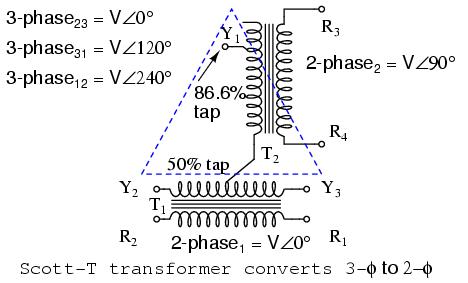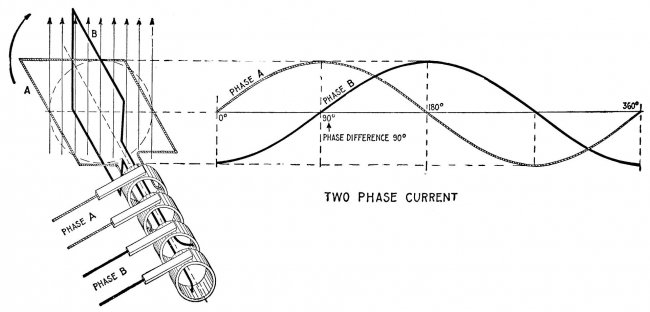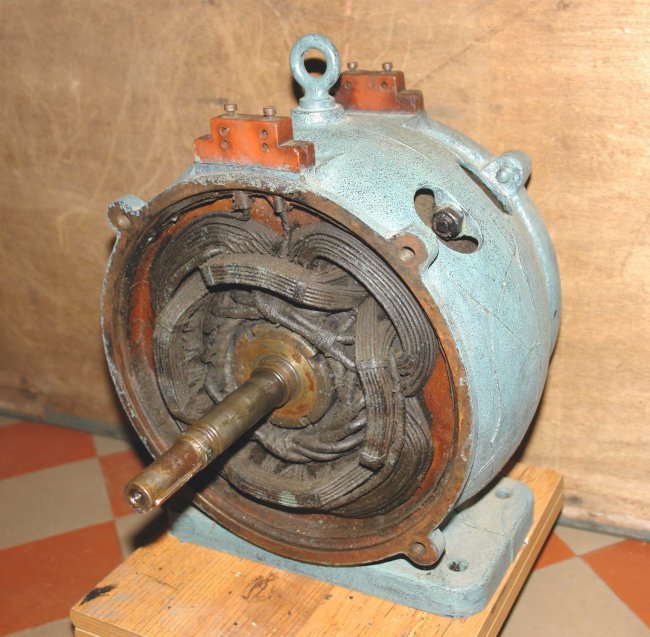Two-phase alternating current system
The two-phase system was the forerunner of today's three-phase system. Its phases were shifted by 90 ° relative to each other, so that the first had a sinusoidal voltage curve, the second - cosine.
Most often, the current was distributed on four wires, less often on three, and one of them had a larger diameter (it had to be calculated for 141% of the current in separate phases).
The first of these generators had two rotors rotated 90° to each other, so they looked more like two connected single-phase generators set to produce two-phase alternating voltage. The generators installed at Niagara Falls in 1895 were two-phase and were the largest at the time.
A simplified diagram of a two-phase generator
The two-phase system had the advantage of allowing asynchronous electric motors.
The rotating magnetic field, which creates a two-phase current, provides the rotor with a torque that is able to turn it from rest. A single phase system cannot do this without the use of starting capacitors. The winding configuration of a two-phase motor is the same as for a single-phase capacitor-start motor.
It was also easier to analyze the behavior of a system with two completely separate phases. In fact, it was until 1918 when the method of symmetrical components was invented, which made it possible to design systems with unbalanced loads (basically any system where for some reason it is impossible to balance the loads of the individual phases, usually residential) .
Two-phase motor winding circa 1893.
Majority stepper motors can also be considered as two-phase motors.
Three-phase distribution, compared to two-phase distribution, requires fewer wires for the same voltage and the same transmitted power. This requires only three wires, which significantly reduces the cost of installing the system.
As a two-phase current source, a special generator was used, which had two sets of coils rotated relative to each other by 90 °.
The two- and three-phase systems can be connected directly using two transformers in a so-called Scott connection, a solution that is cheaper and more efficient than using rotary converters.

Scott circuit: phases Y1, Y2, Y3 of a three-phase system; R1, R2 — one phase of a two-phase system, R3, R4 — the second phase of a two-phase system
At the time when I was changing from a two-phase system to a three-phase system, it was necessary to decide how to evenly distribute the load of two-phase machines on a three-phase system in order to balance it, because the individual phases cannot be regulated separately.
In addition, it can convert electricity not only from a three-phase system to a two-phase system, but also vice versa, thereby ensuring the interconnection between larger electrical units and the exchange of energy between them.
Assuming that the voltage on the three-phase and two-phase sides should be the same, one of them is heard right in the middle, the winding splits 50:50 and its ends are connected to two phases, and the other has only 86.6% of the winding , accordingly, a branch is created there...
This second transformer is connected to the center of the first, and the tap is connected to the remaining phase. A current is then produced on the secondary windings, which are displaced by 90 ° relative to each other.
Unfortunately, this connection is not able to balance the unbalanced load of the individual phases, the imbalance of a two-phase system is transferred to a three-phase system and vice versa, depending on which source is connected.
The system has now been replaced by the more modern three-phase system almost everywhere in the world, but the system is still used in parts of the US, such as Philadelphia and South Jersey in the US (where it is in decline). The reasons why this system still works are historical.
The single-phase, three-wire utility network that is particularly common in North America is sometimes incorrectly called a two-phase system, even though it is a single-phase system in the main installation.


